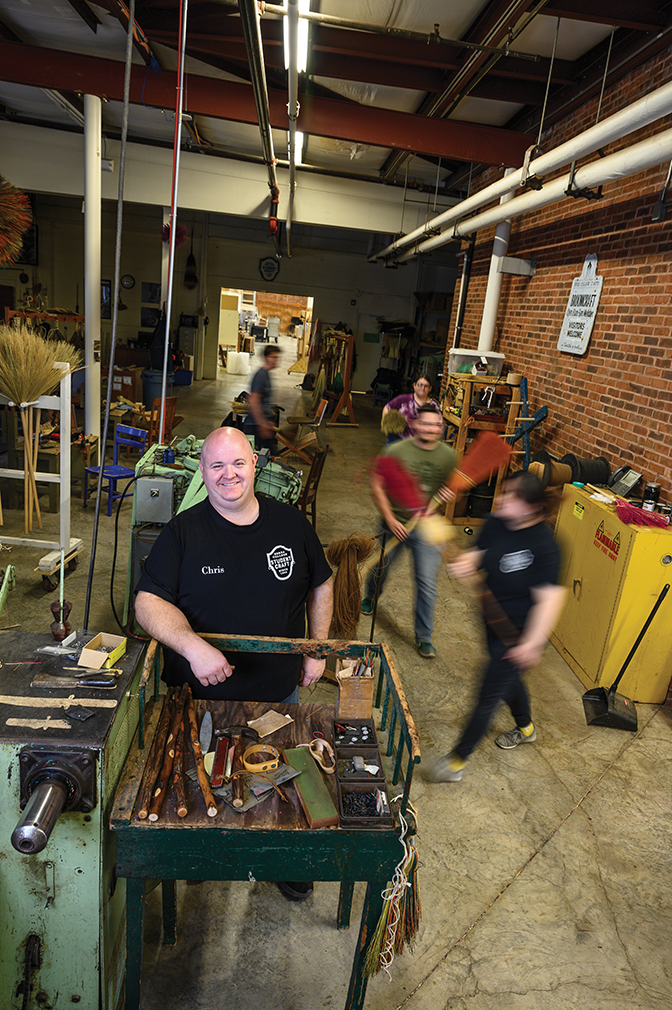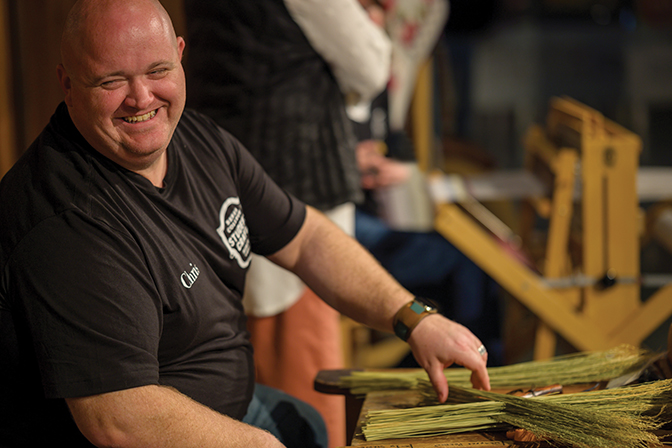While broomcraft was largely an artform left in the past with an estimated 250 makers globally, the craft is now making a resurgence. Berea College Director of Broomcraft Christopher Robbins is one of those leading the movement.
Raised on a farm where he kept his hands busy, by a parent who worked as a schoolteacher, it was only natural for Robbins to follow suit and teach broommaking. He began working with the College in 2010 and has been making brooms ever since.
“Berea College has been making brooms for over 100 years, so I don’t take this position lightly,” Robbins said. “I went from making brooms for myself to having 10 employees, and I love teaching them.”
While the practice of broommaking has historically been exclusive and coveted, Robbins takes pride in teaching the craft and passing down its traditions.
“If there’s someone who wants to learn, I invite them to come sit down and do it with me,” Robbins said. “I’ve met broommakers who refused to teach for the sake of competition, and I’ll never have that approach.”
At Berea—one of 10 federally recognized work colleges—broom-
making is work not competition. Robbins supervises 15 broomcraft students who work at least 10 hours a week as part of the College’s labor program.
“I not only teach them how to make something most people wouldn’t think twice about (the common household broom),” Robbins said, “I also teach them to take pride in what they do and to love what they do.”

Robbins recognizes the importance of not only having a creative outlet, but also crafting a tangible product. He encourages his students to keep their first broom, no matter how rough it may be.
“Even today, after making brooms for more than half my life, I still love to hear someone admire something I made with my hands,” Robbins said.
Student Craft products are admired at Berea and beyond. The online catalog showcases students’ beautiful work, and Broomcraft has received accolades from all over the country. Robbins and his students have been featured in The New York Times and even The Smithsonian Magazine.
This past July marked the 24th anniversary of Robbins’ very first kitchen broom, and he still has it. A product of a two-hour teaching session on a random Saturday, Robbins has Jim Harmon to thank for his passion for the craft. While attending a craft festival in Berea, Ky., he met Harmon from Shaker Village, a national historic landmark in Kentucky dedicated to Kentucky Shakers that houses the largest private collection of original 19th-century buildings. At first, he was reluctant to teach young Robbins.
“He joked that he might be increasing his own competition by teaching me,” Robbins said. “But he was impressed by my age and interest in something other than video games, so he gave in.”
Little did either of them know that Robbins would not only master the craft but pass down the tradition.
That one lesson was all it took. Robbins was hooked on the craft and began making brooms on weekends and after school. In high school, he arranged his schedule so he could simultaneously take business classes at Somerset Community College. He had a vision: hone his craft and sell brooms.
“I did between 10 and 12 shows a year,” he said. “At the time, there were very few people in the world who made brooms, so I became pretty well known.”
Since coming to Berea, Robbins has acted in many roles: mentor, teacher and manager.
My favorite part of my job is watching their progress. Anytime they run into a situation they don’t feel like they can succeed, I tell them to look back at that first, likely ugly broom. They didn’t know how a broom was made when they first came to Berea, now look at what they can do!
Christopher Robbins
“My favorite part of my job is watching their progress,” Robbins said of his students. “Anytime they run into a situation they don’t feel like they can succeed, I tell them to look back at that first, likely ugly broom. They didn’t know how a broom was made when they first came to Berea, now look at what they can do!”
Berea’s broommaking cohort’s next steps include an exhibit at the University of Wisconsin. Each staff member in Student Craft has been given 80 paid hours to develop their skills and create a craft item for display in the exhibit. The opportunity to be financially supported as an artist, regardless of sales, is hard to come by.
“The guarantee to be paid as an artist and to have paid opportunities to hone my own skills is a game changer,” Robbins said. “It helps us make our business better, too.”
Beyond the labor program, Berea also has a new apprenticeship program for makers to observe and practice the craft with the support of experts on campus. Robbins is confident the broommaking program will continue to grow and hopes the craft continues to gain visibility across the globe.



Gorgeous brooms! I have two, a slim in red and green, and the whisk with dustpan.
Thank you! I’m so glad you love your brooms!